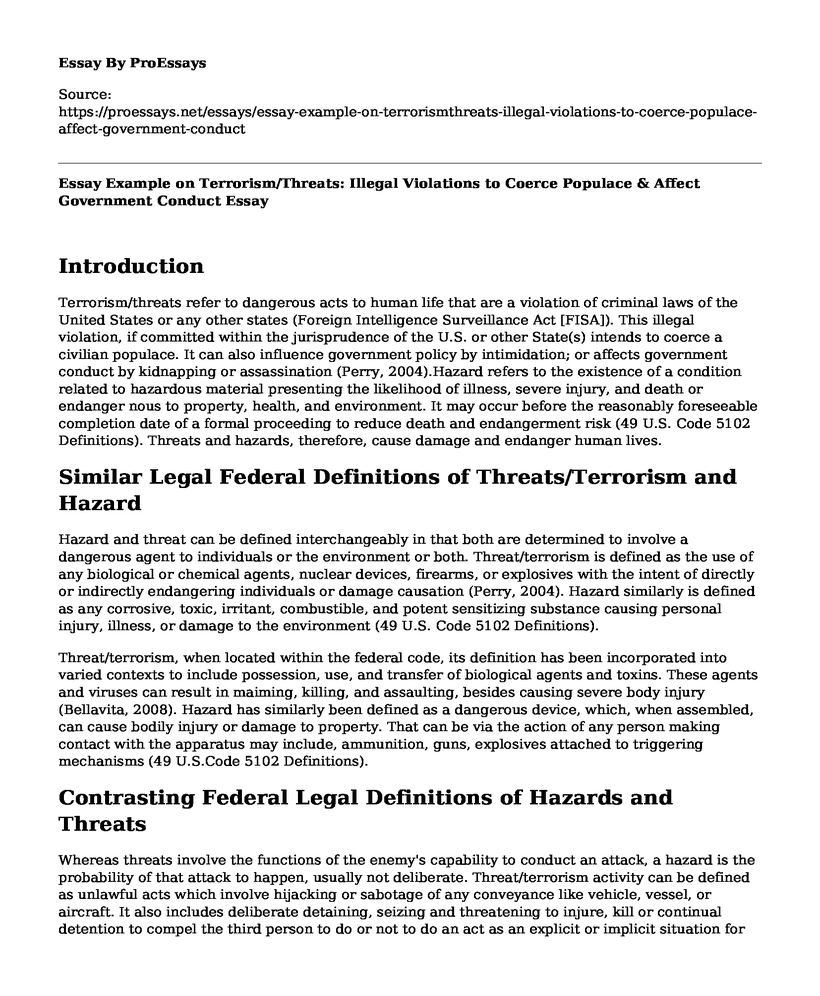Introduction
Terrorism/threats refer to dangerous acts to human life that are a violation of criminal laws of the United States or any other states (Foreign Intelligence Surveillance Act [FISA]). This illegal violation, if committed within the jurisprudence of the U.S. or other State(s) intends to coerce a civilian populace. It can also influence government policy by intimidation; or affects government conduct by kidnapping or assassination (Perry, 2004).Hazard refers to the existence of a condition related to hazardous material presenting the likelihood of illness, severe injury, and death or endanger nous to property, health, and environment. It may occur before the reasonably foreseeable completion date of a formal proceeding to reduce death and endangerment risk (49 U.S. Code 5102 Definitions). Threats and hazards, therefore, cause damage and endanger human lives.
Similar Legal Federal Definitions of Threats/Terrorism and Hazard
Hazard and threat can be defined interchangeably in that both are determined to involve a dangerous agent to individuals or the environment or both. Threat/terrorism is defined as the use of any biological or chemical agents, nuclear devices, firearms, or explosives with the intent of directly or indirectly endangering individuals or damage causation (Perry, 2004). Hazard similarly is defined as any corrosive, toxic, irritant, combustible, and potent sensitizing substance causing personal injury, illness, or damage to the environment (49 U.S. Code 5102 Definitions).
Threat/terrorism, when located within the federal code, its definition has been incorporated into varied contexts to include possession, use, and transfer of biological agents and toxins. These agents and viruses can result in maiming, killing, and assaulting, besides causing severe body injury (Bellavita, 2008). Hazard has similarly been defined as a dangerous device, which, when assembled, can cause bodily injury or damage to property. That can be via the action of any person making contact with the apparatus may include, ammunition, guns, explosives attached to triggering mechanisms (49 U.S.Code 5102 Definitions).
Contrasting Federal Legal Definitions of Hazards and Threats
Whereas threats involve the functions of the enemy's capability to conduct an attack, a hazard is the probability of that attack to happen, usually not deliberate. Threat/terrorism activity can be defined as unlawful acts which involve hijacking or sabotage of any conveyance like vehicle, vessel, or aircraft. It also includes deliberate detaining, seizing and threatening to injure, kill or continual detention to compel the third person to do or not to do an act as an explicit or implicit situation for the release of the seized individual (Bellavita, 2008). That is contrary to hazard, which can be defined as industrial chemical substances in liquid, solid, or gas form that affect the living organisms, people, and property in that particular environment. That can happen due to exposure of such substances or when storage and transportation precautions are not adhered to (49 U.S.Code 5102 Definitions).
Conclusion
While the threat may be designated by one party to act against the other party, the hazard can be an unintended pollutant that affects everyone in the entire area without prejudice. In criminal law, the threat is defined as a menace or one's declaration of his/her intention to cause harm to the person, destroy property by an unlawful commission of an act. It is primarily meant to unsettle the mind of the designated person and instill fear (Perry, 2004). Hazard, on the other hand, is defined as exposure of poisonous, flammable, corrosive, and oxidizing substances to the atmosphere. The contents may cause critical illness or death to everyone around the affected area (49U.S. Code 5102 Definitions).
References
Bellavita, C. (2008, June).Changing Homeland Security: What is Homeland Security? HomelandSecurity Affairs, 4(1). Retrieved from https://www.hsaj.org.
Perry, J. (2004) The Numerous Federal Legal Definitions of Terrorism: The Problem of toomany Grails. Journal of Legislation, 30(2). Retrieved from https://scholarshiplaw.nd.edu.
49 U.S. Code 5102 Definitions. (1994, July). Transportation: Transportation of HazardousMaterial. Legal Information Institute, 51(5102).Retrieved from https://www.law.cornell.edu.
Cite this page
Essay Example on Terrorism/Threats: Illegal Violations to Coerce Populace & Affect Government Conduct. (2023, Feb 23). Retrieved from https://proessays.net/essays/essay-example-on-terrorismthreats-illegal-violations-to-coerce-populace-affect-government-conduct
If you are the original author of this essay and no longer wish to have it published on the ProEssays website, please click below to request its removal:
- Critical Analysis Of Essay: Distribution of Resources and Poverty Universal Basic Income
- Essay Sample on Post-Traumatic Stress in Children and Adolescents Exposed to Domestic Violence
- Why Violence Against Women and Indigenous People Persists in Canada - Research Paper
- Technologies in Criminal Justice
- Essay on Deaf Man Files Discrimination Case Against Oakland County
- Essay Example on Media Coverage of Terrorism Attacks: Fear and Mixed Emotions
- Paper Example on Believing Women in Islam: Unread Patriarchal Readings of the Qur'an







